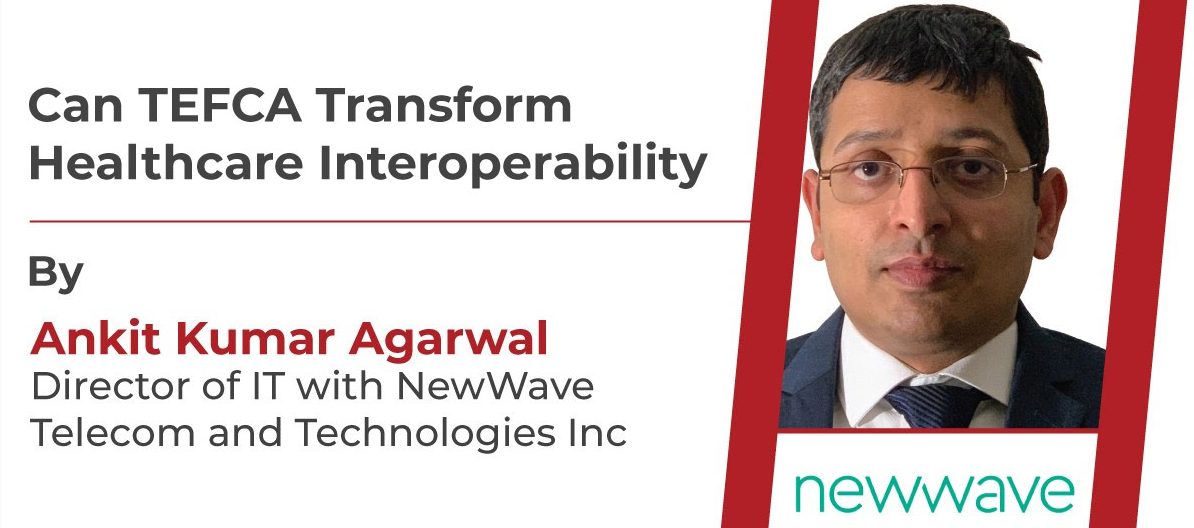
Ankit Kumar Agarwal
Ankit Kumar agarwal is a Wharton Graduate and working as “Director of IT” with NewWave Telecom and Technologies Inc. Ankit is passionate about bringing impactful changes in people’s life and writes blogs to educate people and promote digital Health.
What is TEFCA
TEFCA (Trusted Exchange Framework and Common Agreement) is a framework developed by the Office of the National Coordinator for Health Information Technology (ONC) in the United States to promote interoperability among electronic health record (EHR) systems and other health information technology (HIT) systems. The goal of TEFCA is to facilitate the exchange of health information between different systems and providers, in order to improve the efficiency, effectiveness, and quality of healthcare.
TEFCA sets out a set of technical, operational, and legal standards and requirements for the exchange of health information. It also establishes a common agreement between participants in the exchange, outlining the roles and responsibilities of each party. By establishing a common framework and agreement, TEFCA aims to create a more seamless and secure environment for the exchange of health information, which can ultimately lead to better care for patients.
TEFCA is one of several initiatives aimed at improving interoperability in healthcare. Other efforts include the use of standards such as Fast Healthcare Interoperability Resources (FHIR) and the adoption of APIs (Application Programming Interfaces) to facilitate the exchange of data between systems.
How does TEFCA Impact HL7 Implementations
TEFCA, or the Trusted Exchange Framework and Common Agreement, is a set of policies and standards designed to facilitate the exchange of electronic health information between different health information exchange (HIE) organizations. It is intended to establish a framework for interoperability, security, and privacy in the exchange of electronic health information.
In terms of HL7 implementations, TEFCA specifies the use of certain HL7 standards and implementation guides for the exchange of electronic health information. This includes the use of HL7 FHIR (Fast Healthcare Interoperability Resources) as the primary standard for data exchange. HL7 FHIR is a set of standards for exchanging healthcare information electronically, and it is designed to be flexible, modular, and easy to implement.
TEFCA also specifies the use of certain security and privacy standards, such as those from the National Institute of Standards and Technology (NIST), to ensure the confidentiality, integrity, and availability of electronic health information during exchange.
To implement HL7 standards in accordance with TEFCA, HIE organizations must follow the guidelines and requirements outlined in the TEFCA document. This includes using the specified HL7 standards and implementation guides, as well as adhering to the security and privacy requirements outlined in TEFCA.
It is important to note that TEFCA is not a mandatory requirement, but rather a voluntary framework that HIE organizations can choose to adopt in order to facilitate interoperability and secure data exchange.
Which HL7 Implementation Guides are impacted by TEFCA
TEFCA requires participants in the trusted exchange network to support the use of certain HL7 implementation guides as part of their participation in the network. These HL7 implementation guides include:
- HL7 FHIR (Fast Healthcare Interoperability Resources) Implementation Guide for SMART on FHIR: This guide specifies how to use FHIR to exchange clinical data as part of the SMART on FHIR framework.
- HL7 v2 Implementation Guide for Healthcare Provider Directory: This guide specifies how to use HL7 v2 standards to exchange information about healthcare providers, such as their name, location, and contact information.
- HL7 v2 Implementation Guide for Patient Demographics Query: This guide specifies how to use HL7 v2 standards to exchange patient demographic information, such as name, date of birth, and address.
- HL7 v2 Implementation Guide for Clinical Information Recipient: This guide specifies how to use HL7 v2 standards to exchange clinical information, such as lab results and vital signs.
- HL7 CDA (Clinical Document Architecture) Implementation Guide for Discharge Summary: This guide specifies how to use CDA standards to exchange structured clinical documents, such as discharge summaries.
TEFCA requires participants to support these implementation guides in order to facilitate the interoperable exchange of health information within the trusted exchange network.
Guidance to the HIEs
As we deal with Billions of data exchange request on yearly basis, it is getting critical to explore the interoperability options to ensure that the data transfer from the discrete systems become seamless. TEFCA as a framework helps set the guidelines but the onus lies on the various healthcare stakeholders to build consensus to achieve the end goal to make entire healthcare system interoperability to improve efficiency and improved member health outcomes.
*This article is Peer Reviewed by the Distilinfo Editorial team prior to the publication.*


